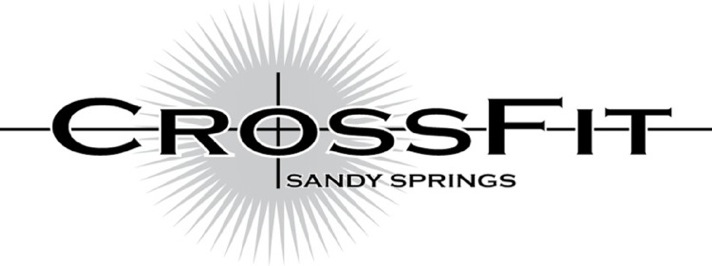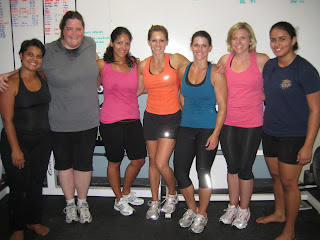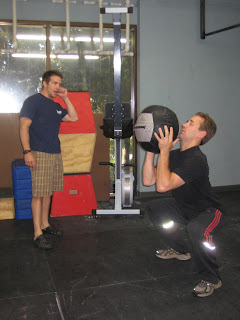"Paul"
5 rounds for time of:
50 Double Unders
35 Knees to Elbows
185 lb. Overhead Walk 20 yards.
Pittsburgh Police Officer Paul John Rizzo Domenic Sciullo II, 36, was shot and killed in the line of duty while responding to a domestic disturbance callon April 4, 2009. He was engaged to be married with Lisa Esposito.Sunday hiking is on! The weather (as of friday night) has improved and it might be a nice day. We're still meeting at 8 a.m. in the parking lot of CFSS. If you're planning on coming please make sure to bring a rain jacket, lunch and snacks, at least 2 liters of water and shoes. Something to carry all that in wouldn't be amiss either.
We pinched this article from Mark's Daily Apple. It is dedicated to those of you that complain about lower back issues… People are exceedingly mobile these days. We can jet halfway across the world at a moment’s notice, check email on our phones, hop in the car and be in another state in five hours, conduct business from anywhere, transfer schools, and shave while reading the paper on the morning commute. Social mobility, financial mobility, spatial mobility, information mobility. Mobile workforce, mobile phone, Google Mobile. Yeah, clearly, mobility is highly prized.
What about joint mobility?
Too many people discount, or even outright ignore, this crucial aspect of physical fitness. Raw strength, speed, and stamina are all important, especially to athletes or weekend warriors, but everyone of any age or fitness level needs the ability to move their limbs and joints through their full range of motion as ordained by nature. That goes for grandmothers, teens, and couch potatoes alike. Though not everyone will be picking up barbells or running sprints or long jumping, we all have to function in a three-dimensional world. We all have space and gravity with which to contend if we’re planning on enjoying and experiencing all life offers, and that’s accomplished by moving through spatiality and against gravity. To thrive in this environment, we require the full, unfettered use of our limbs, joints, and muscles. Losing the shoes is a big step; so is getting strong and fit. One of the biggest, in my opinion, is regaining and maintaining maximum joint mobility.
“Regaining,” because we are born with joint mobility. Ever watch children play? They’re bendy, flexible little sprites with perfect squat and deadlift form. And they don’t need formal training to get there! Attainment of joint mobility, then, is regaining what was lost, not inventing something new.
Regaining’s the easy part. You’ve got to maintain your mobility, too, or else you run the risk of misplacing it all over again. Once you learn the mobility exercises, it’s actually really pretty simple to maintain. People generally fail out of sheer forgetfulness or laziness. If you can incorporate mobility drills into your regular warm-ups or daily activities (or even institute them as standalone workouts), maintenance becomes second nature.
Everyone has to pick up groceries, or walk up stairs, or perform any number of mundane tasks requiring the use of joints and limbs. If those joints and limbs are going to be useful, they have to be mobile. They need a full range of motion.
And if you are an athlete, mobility is even more important. Strength without the ability to move your body and limbs fully and completely – without the ability to use your strength in the real world – is pointless. Strength development itself suffers without proper joint mobility. The strongest lifters are the ones who move weights (or just themselves) through the full range of motion using compound movements and utilizing healthy, active joints. If you have poor joint mobility, performing quality squats, deadlifts, presses – any compound movement that requires precision and communication between joints and limbs – it’s going to be that much harder, and the risk for injury that much higher.
Power output and speed will be compromised with poor joint mobility. When you shoot a rubber band, the farther back you pull it, the more tension there is, and the farther it shoots. The greater your joint mobility, the greater your range of motion, and the more tension – and therefore power – you’ll be able to generate.
Most importantly, maintaining adequate joint mobility keeps our joints healthy. Just as our bones and our muscle fibers require physical stimuli, like load-bearing activities, to maintain strength, density, and to initiate positive structural changes/adaptations, our joints require regular movement and usage to maintain health and mobility. Think of your joints as hinges to a door; if the door is never opened, never used, and subjected to steady environmental or elemental decay without reprieve, that hinge isn’t going to work well. It’s going to rust, and it’ll creak and groan if you’re even able to get it moving. Same thing goes for the sedentary office worker, the bodybuilder who only focuses on pecs and biceps, and the daytime TV watcher. Their joints aren’t being used to their full potential (if at all, in some cases), and their mobility will suffer. Like the Tinman in Oz, their joints will “rust” over and the simplest tasks will become difficult, almost Herculean in extreme cases (and in old age).
Hip Mobility
Our joints, limbs, and muscles represent a collective of individual pieces, all working together to move the body, manipulate objects, and propel us through three dimensional space. Mobility in all areas is crucial, but it helps to consider them in segments. After all, different people will have different levels of mobility in different areas of the body. Perhaps the most common mobility deficiency resides in the hips. In my own case, it was a lack of hip mobility that was the proximate cause of my downfall as a runner/triathlete. I basically “seized up” after fifteen years of overuse in a very limited plane of movement.
People have forgotten (or don’t know) how to use their hips the way evolution designed them to be used. Instead of sitting back with their hips to pick something up, followed by a hip extension (thrust forward) to bring it up, they’ll bend at the waist and lift with the lower back. Picking up a potted plant? You can get away with poor hip mobility – for a while. Picking up a weighted barbell, a child or a bag of peat moss with poor hip mobility using your lower back? That’s an injury waiting to happen.
We sit too much. I know I do, and it’s especially bad to do so right after working out (yet I still do it sometimes). Sitting impacts hip mobility in two major ways: it weakens the glutes and it shortens the hip flexors. Both your glutes and your hip flexors figure prominently in the activation of your hips, so when they’re weak and/or inactive, the lower back takes over. Now, the lower back, or the lumbar spine, isn’t designed for a ton of activity. It’s mainly there to provide support and stability. It’s the core, after all. But with poor hip mobility brought on by excessive sitting and a weak posterior chain, your hip extension is no longer sufficient, and in comes the lower back. That potted plant is beginning to look a little heavier, eh? And that’s not even mentioning the barbell.
It’s a shame, because our hips are obviously designed to generate a ton of power. The ligaments, the tendons, the musculature, and the bones in that region are all dense, hardy, and robust – they’re made for activity and mobility – but too many people are selling their hips short. And when that happens, the other joints and muscles (like knees or lumbar spines) have to pick up the slack. It’s an adaptive mechanism that perhaps any multi-limbed animal possesses: the quick substitution for an injured limb/joint by an adjacent one. It’s not meant to be a lasting solution, though. We’re not meant to limp through life using one joint to do another’s prescribed task. It just doesn’t work, and it’s exactly why most people lift with their backs instead of their hips and then complain about back or knee pain.
Restoring hip mobility will help in several areas. It should reduce or eliminate lower back and/or knee pain stemming from overcompensation. It should improve your power output by allowing you to fully engage your posterior chain in training exercises like squats, deadlifts, kettlebell swings, and any of the Olympic lifts, while making them safer. It should improve the strength and power of your hip extension, extremely vital for performance of the aforementioned lifts, but also for vertical leaps, sprinting, and any basic explosive movement. It will improve your rotational strength; instead of rotating with the lumbar spine (a huge no-no), you’ll generate power with the hips – perfect for throwing a good punch, swinging a golf club, or tossing a big rock at prey. It’ll improve speed, especially sprinting speed.
Most of all, hip mobility will improve your relationship with the rest of your body. Because the hips are the most common sites of poor mobility, many people are walking around with dysfunctions borne of overcompensation. Fixing hip mobility won’t fix everything, but it will eliminate a major stressor on your system as a whole and allow you to focus on the smaller, but no less important, sites and joints.



































